| KING OF THE ROYAL MOUNTED |
|
|
| Great buzzsaw cliffhanger scene |
KING OF THE ROYAL MOUNTED (1940). 12 chapter Republic serial. [NOTE: a feature film with this title,
also inspired by a Zane Grey story, came out in 1936.] Directed by William Witney and John English. The “King”
of the title is Sgt. Dave King (Allan Lane), the handsome, stalwart mountie whose father, Inspector King (Herbert Rawlinson
of Blake of Scotland Yard) is an inspiration to him. Both men and their colleagues
find themselves in a vicious battle with enemy agents who want to get their hands on “compound X.” The compound
was originally developed to cure infantile paralysis, but with the addition of another element it becomes a deadly explosive.
Although King of the Royal Mounted may seem prosaic compared to other, wilder
serials, it is highly entertaining and very fast-paced. Highlights include an overhead trap full of spikes, a tub of boiling
liquid that nearly boils the hero, and a buzzsaw that almost slices King in half. Another good scene has the convalescents
in wheelchairs in a sanitarium all turn out to be felons, and the sanitarium their lair. A crusty old-timer named Vinegar
(Budd Buster) doesn't appear often enough to become too annoying. It's almost funny when young King tells another handsome
mountie, Corporal Tom Merrick (Robert Kellard), not to worry about their impending death because “we can't live forever”
-- easy for him to say! Richard Travis, who has a bit part as Constable Hallett – his first role -- was Bette Davis'
leading man in The Man Who Came to Dinner. He later appeared in Missile
to the Moon.
HAUNTED HARBOR (aka Pirate's Harbor). 15 chapter Republic
serial. Directed by Spencer Bennet and Walter Griswold. On the island of Amoa, Jim Marsden (Kane Richmond) is falsely accused
of a murder and nearly executed but he escapes with the help of some friends. Sailing to another island, which, oddly, resembles
California, he encounters Patricia Harding (Kay Aldridge) and her father and saves them from drowning. The actual murderer,
Carter (Roy Barcroft), winds up on the same island as Marsden and has taken the identity of Kane, whom Marsden never suspects
is the man he's looking for. For fifteen chapters Kane and his men try to off Marsden and Pat, to no avail, although they
do succeed in murdering Pat's father and others. There are some splendid fight scenes in this – almost too many of them,
in fact – although on occasion it's obvious that, say, a stuntman is hurling himself onto a table instead of being thrown on it by the punch he's received. The bad guys are trying to keep natives away
from a certain harbor via use of a mechanical sea monster that looks like a Chinese dragon and is about as realistic. This
thing wouldn't fool the natives or anyone else in the daytime; while colorful-looking it is almost completely immobile. There
are at least two memorable cliffhangers: Marsden is climbing a very tall ladder at a cliff's edge when a villain pushes it
over; and Patricia is tied to a post with an air drill attached to the door aimed right at her head [when someone opens the
door – ka boom!] The effective musical score is by Joseph Dubin. Haunted Harbor is reasonably entertaining, but not that memorable.
THE BLACK WIDOW. 13 chapter Republic serial. Directed by Spencer Bennet
and Fred C. Brannon. After a series of murders of the associates of a scientist named Weston, the Clarion newspaper calls
in mystery writer Steve Colt (Bruce Edwards) to solve the crimes, which doesn't impress reporter Joyce Winters (Virginia Lindley)
one bit. But their adversarial relationship soon blossoms into an informal partnership as they try to track down the “Black
Widow” who's behind the killings. Her real name is Madame Sombra (Carol Forman),
and she's after the atomic rocket invented by Weston so that her father, Hitomu, can use it to take over the world. Hitomu
is a geeky character who materializes in his chair from around the world in a puff of smoke. [What does someone who can master
teleportation need with Weston?] The Black Widow can disguise herself as anyone using a variety of masks [like the villain
in Hurricane Express] and uses a fake spider that pops out of the back of a chair
to sting and poison her victims. Her gang members use a special mist to give their getaway cars a new paint job even as they're
on the run. This is an exciting, fast-paced, better-than-average serial with several memorable cliffhangers. In one chapter
Steve and Sombra's gang battle it out in the back of an airplane. Unbeknownst to Steve, Joyce is locked in a trunk which nearly
goes hurtling out the open door each time the plane dips in one direction or another! Later Steve and Joyce race down a mineshaft
to escape a ball of fire only to find the exit barred. A shattered pane of glass nearly serves as a guillotine as Joyce lays
unconscious beneath it. In a later cliffhanger, however, Steve is shown jumping out of his car long before he could possibly
realize that it would fly off the bank into a rushing river. The hero in this is dull-witted and bland -- Edwards is a competent
but uninteresting actor -- although Joyce/Lindley is at least feisty at times; she smacks Sombra with a detached steering
wheel at one point. Although hardly the female equivalent of Charles Middleton [Ming the Merciless], Carol Forman is cold,
heartless and formidable as the Black Widow; it's a credible performance. The rich, excellent score was undoubtedly borrowed
from an earlier serial. William Schoell.
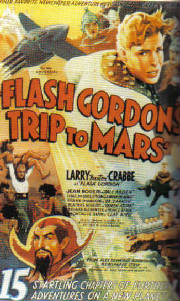 FLASH GORDON'S TRIP TO MARS. Directed by Robert Hall and Ford Beebe. This is the second of the three
Flash Gordon serials. Flash, Dale Arden and Dr. Zarkov again go into space when they discover that Nitrogen is being sucked
off the Earth, and assorted disasters caused, by a beam from Mars. Emperor Ming the Merciless, who somehow survived his death
at the end of Flash Gordon, is up to his old tricks, this time in alliance
with the bitchy Martian Queen Azura (Beatrice Roberts), whom everyone refers to as “Your Magnificence.” Azura
has turned all of her enemies into deformed Clay People who must spend the rest of their days in their dank and lonely caverns.
While the Clay People are her enemies, the geeky Forest People are her allies, and they nearly destroy our heroes when Azura
causes the destruction of an idol and frames Flash and company for the job. The Queen gets her magical powers – she
can disappear in a puff of smoke, for one thing -- from black and white sapphires that Ming very badly wants to possess.
In a simple but effective bit of business, the Clay People seem to materialize from out of the very
walls of their cavern, their bodies camouflaged by their similarity to the clay-like stone of the walls. Their appearances
are always backed by some interestingly quirky music as well. There is a bridge made of solidified light that you keep expecting
to figure in a cliffhanger, but never does. The more memorable cliffhangers deal with a moving-rock death trap in the caverns
of the Clay People, and a bit when Flash, paralyzed by a ray beam, can only stand there in horror as an enemy ship bears down
on him. The sequences showing people, including Flash and his buddies, using “bat wings” or special cloaks to
fly through the air are surprisingly effective. Kane Richmond is good in a small role as a Martian who tries to kill Flash
– the two come to blows at one point -- but becomes an eventual ally. Jack Mulhall of The Clutching Hand is also a Martian but gets only one or two lines.
|
|
| Charles Middleton as Imperial Ming [the Merciless] |
Towering over the production is the delightful Charles Middleton as the Imperial Ming. Middleton
approaches the role with just the right mix of esprit and authority. An interesting aspect is Ming's sick sense of humor,
which he displays with a sometimes sinister but just-as-often “good-natured” chuckle between friends – and
enemies. Middleton is never hammy nor does he over-act, saving his more maniacal outbursts for the final scenes when even
his minions think he's gone nuts. Ming is no longer bald but wears a black skull cap. Flash actually apologizes to Ming for
roughing him up at one point – this, the man who has already murdered countless Earthlings – and at the end pleads
for mercy for the despot as he's led into a disintegration chamber. [He somehow survives again to show up in Flash Gordon
Conquers the Universe.] Middleton never really got too many chances to show off his acting chops except in the serials;
mostly he was cast in small or bit parts in films and often wasn't even credited. At least he's achieved some kind of immortality
as Ming. While not in Middleton's class as an actor, the other cast members acquit themselves reasonably well, with Buster
Crabbe making a convincingly heroic and decent Flash Gordon. As Dale Arden, Jean Rogers looks much less luscious as a brunette
than she did as a blond in Flash Gordon. Beatrice Roberts isn't bad as Queen Azura. When she decides to reverse her
spell on the Clay People as she expires [due to Ming's machinations], everyone acts as if she's a candidate for sainthood,
forgetting that she was the one who condemned all those dissenters to a living Hell in the first place!
Flash Gordon's Trip to Mars doesn't necessarily represent the cliffhanger serial at its best, but it is colorful, fast and entertaining –
and boasts the wonderful Middleton as Imperial Ming! Bravo! William Schoell
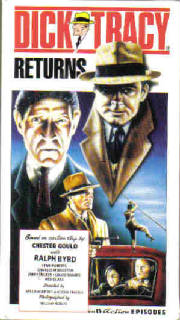
DICK TRACY RETURNS. Directed by William Whitney and John English. Ralph
Byrd is back as the perfect Dick Tracy in the second of four serials, only this time he's got the great Charles [Ming the
Merciless] Middleton as his adversary. In a role that is very different in tone and appearance from Emperor Ming, Middleton
is Pa Stark, the father of a gang of four vicious hoodlums. The episodic serial shows Middleton planning and executing various
crimes, most of which are foiled by Tracy and his men, and alternately trying to rub out his hated G-Man nemesis. Middleton
gives a very gritty and effective performance in this, with absolutely no trace of the Imperial Ming persona. In the first
chapter there is some pathos as young Special Agent Ron Murton is murdered by the Stark gang on his very first assignment,
which gives Tracy an added interest in bringing the fiendish clan down.
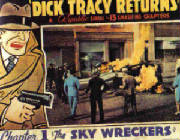 Highlights of the serial include Tracy trying to get a handcuffed associate, Steve, off the top
of a train before it crashes; Tracy being anesthetized and thrown out of a plane; Junior trying to
return a briefcase to an assassin, unaware that there's a bomb in it that might go off at any second; and the climax in which
Tracy at last faces off against Pa Stark thinking that the latter has killed many of his fellow G-Men with a bomb. [A sequence
with a time bomb in a tunnel beneath an observatory is undercut because the writers seem to have confused the mere timer mechanism
with the actual dynamite.] The serial is briskly edited with an exciting [if familiar] score and many well-done action/stunt
scenes. Not a top-notch serial, perhaps, but pretty good nevertheless. William Schoell.
| ZORRO'S FIGHTING LEGION |
|
|
| Zorro faces Don Del Oro |
ZORRO'S FIGHTING LEGION. 12 Chapter Republic Serial. Set in Mexico in 1824, this is one of the very
best serials ever made, continually entertaining, suspenseful, and vibrantly colorful. A white man dresses up in a golden
suit with a huge covering head mask and pretends to be Don Del Oro, the God of the Yaquis. Desiring to become Emperor of Mexico,
he is determined to stir the previously peaceful Yaquis into a bloody rebellion no matter what it takes. Into town comes the
foppish Don Diego (Reed Hadley), who is secretly the dashing Zorro. Zorro makes it his business to unmask Don Del Oro and
stop his plans, and finds himself caught between the members of the town council – one of whom is Don Del Oro –
and the Yaquis, whom he tries to sway to his side. In addition to a room with closing walls, there is a thrilling bit with
a falling mine elevator and other traps. Zorro cleverly disperses a firing squad about to let loose on their target by throwing
a hive with angry bees into their midst. A lot of suspense is worked up over the identity of Don Del Oro, and whether or not
Zorro can convince the Yaquis that the former is an imposter and not a God before they can throw him into a sacrificial
fire. Sheila Darcy is very pretty but has little to do as Volita, the nominal love interest. Reed Hadley is fine as Zorro/Don
Diego, although he sometimes overdoes the mincing to such a degree that his alter ego comes off as stereotypically “gay”
instead of merely foppish. This serial works nearly every step of the way and also has a stirring theme song to boot. Excellent.
William Schoell.
THE WHISPERING SHADOW (1935). 12 chapter Mascot serial. Directed by Albert Herman and Colbert Clark.
As silly and illogical as The Clutching Hand, this serial is also, like Hand, a lot of fun. Bela Lugosi stars [this is not one of his more memorable performances, however]
as Professor Strang, who runs a waxworks called the House of Mystery. Every time a delivery is made to the waxworks by a certain
trucking company, a weirdo calling himself The Whispering Shadow appears to attack the truck with his gang. He can also murder
people from afar via the apparent use of “radio death rays.” Although a criminologist named Robert Raymond (Robert
Warrick) is called in, the true hero of the story is Jack Foster (Malcolm McGregor), the trucking company foreman whose brother
is murdered by The Shadow. He is convinced that Strang is the Shadow, but Strang's daughter Vera (Viva Tattersall) tries to
assure him that this is not the case. Other suspects include Steinbeck (Roy d'Arcy) an “international spy” and
radio expert, and Bradley, president of the firm (Henry B. Walthall), among others. It seems that The Whispering Shadow –
and virtually every other character – are after the Czar's jewels that may be hidden in the warehouse of the trucking
company. The end of chapter two features one of the best “the walls are closing in” cliffhangers of any serial.
The story gets rather confusing at times, and there are too many flashbacks, but the serial is suspenseful and holds your
attention. Another highlight is a very effective shot of the villain's outsized shadow dominating the corner of a room. William
Schoell.
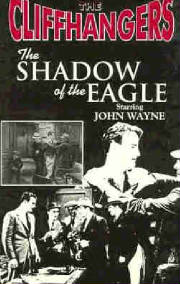 SHADOW OF THE EAGLE (1932). 13 chapter Mascot serial. Director: Ford Beebe. A famous flier called the
Eagle, who was presumed to be dead, is actually Nathan Gregory (Edward Hearn) the owner of a flea-bitten carnival. He claims
that the directors of an aircraft factory [all of whom were in the same squadron with him] stole his idea and have made millions
off of it. Naturally, when someone calling himself the Eagle begins skywriting the names of directors just before they're
murdered, he becomes the likeliest suspect. But his daughter Jean (Dorothy Gulliver) and her boyfriend Craig McCoy (John Wayne)
believe that he may be innocent, and that one of the directors is killing off the others to claim all the profit for himself.
The serial begins with a highly cinematic and dizzying look at the exciting offerings of the carnival, and then becomes a
fairly standard but entertaining battle of wits between Wayne and his pals and the Eagle and his henchmen, with the corporation
directors caught in the middle. The pulp-style story makes little sense at times and there are definite holes in the logic.
The cliffhangers end very abruptly and the serial itself cries out for music. Still, there are some memorable scenes in this:
The Eagle, at a distance, carrying off Jean in his remote-controlled plane and sending it rushing to Earth in one harrowing
bit; a fight between Wayne and an Eagle henchman high on a ferris wheel, shot from faraway [Wayne somehow survives a fall
from said ferris wheel]; and a suspenseful sequence when it appears as if Wayne is going to be staked through the heart by
his cronies at the carnival. The midget Billy (Little Billy) and the likable Strongman (Ivan Linow) that he picks on make
an amusing combo. Wayne's natural emoting is in stark contrast to the wooden playing of other serial heroes and probably contributed
greatly to his breaking out of the cliffhangers and becoming a major star. Dorothy Gulliver makes an appealing heroine, although
the suspects in this are fairly interchangeable. William Schoell.
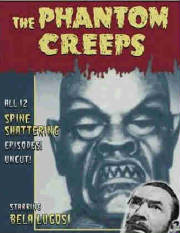 THE PHANTOM CREEPS (1939). Thirteen chapter serial; Universal [Commonwealth]. Directed by Ford Beebe
and Saul A. Goodkind. Bela Lugosi displays his customary presence and authority and greatly bolsters this bizarre but entertaining
cliffhanger about a demented scientist, Dr. Zarkov (Lugosi), who wants to take over the world with his inventions. The secret
of his power is a meteorite he found that contains explosive energy, and which is stolen from him by both good guys and bad
– and stolen back – repeatedly throughout the chapterplay. Zarkov can also turn invisible and, after he fakes
his own death, sneaks about as The Phantom making mischief – and stealing back the meteorite, of course. He employs
a giant robot or Iron Man that is well-designed with its hideous, scary face, and effectively brought to life by the man inside
the outfit and assorted gears. He also uses creepy black mechanical spiders that emit a mist that causes suspended animation.
Both the government and a nest of spies who operate out of the International School of Languages want to get their hands on
Zarkov's inventions, but he is determined to keep them for himself. One would think that Zarkov could make a fortune merely
patenting his strange spinning device that can perform painless, bloodless surgery – he extracts a bullet from his henchman
Monk with it -- and take over the world financially, but like all mad scientists he doesn't think too clearly.
The Phantom Creeps has more than its share of silly moments,
with mostly lame cliffhangers, but the pace is fast and the invisibility FX – if simplistic – are well-done. Robert
Kent plays investigator Bob West, and Dorothy Arnold is intrepid gal reporter Jean Drew. Regis Toomey plays Kent's fellow
agent, Jim Dale. A bit when a train plows into a car certainly has, ahem, impact. Bela is delightful as he sits in his plane
and lobs bombs at ships below, laughing all the while. The music is culled from the Universal vaults or rips off some classical
themes. Not without flaws but a lot of fun. William Schoell.
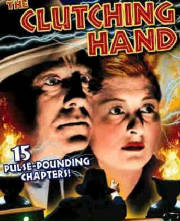 [The Amazing Exploits of] THE CLUTCHING HAND. Director: Albert
Herman. Jack Mulhall stars as Craig Kennedy, allegedly super-detective who is called in when a scientist, Dr. Gironda, is
kidnapped and his formula for synthetic gold disappears. Apparently the villain is Kennedy's old enemy, the Clutching Hand,
who reveals that he has Gironda but still doesn't have the formula, which he will do anything to obtain. We see only the silhouette
of the Clutching Hand with his out-stretched arm, hunched over body, and the maniacal laugh that even plays over the end credits
of each chapter. The Clutching Hand is certainly malevolent and secretive but he is hardly a master criminal genius along
the lines of Professor Moriarity or Dr. Mabuse, and his crimes are comparatively petty. Much of the action takes place at
the seedy Harbor Hotel, which is the den of thieves, or on the ship the Nellie D, or the Gironda estate, but wherever it is
there are an awful lot of very convenient trapdoors, secret panels, hidden staircases and assorted hidey holes.
|
|
| two-fisted action in THE CLUTCHING HAND |
There are a lot of very lively fight scenes – especially a great
bar fight with dozens of toughs in chapter eight – even though the feinting is more obvious than usual. In one unintentionally
comical moment the Clutching Hand reaches out towards a woman's face and is practically up her nostrils before she sees the
appendage. A lot of suspense is generated over the identity of the villain, who could literally be anyone, but when his identity
is finally revealed the audiences in 1939 were undoubtedly scratching their heads in confusion – duh? Let's just say
that the plot of The Clutching Hand doesn't hold up to close scrutiny, to put
it mildly. While the cliffhangers themselves may not be that imaginative, overall the serial is quaint, amusing, and a great
deal of fun. William Schoell.
HURRICANE EXPRESS (1932). 12 chapter Mascot Serial. Director: Armand Schaefer. John Wayne registers
star charisma and a decided acting ability even in this early serial wherein he plays a pilot who vows to get even with the
unknown criminal, known as “The Wrecker,” who was responsible for his engineer father's death when he causes the
famous Hurricane Express to crash. [Wayne shows genuine emotion when he discovers his father's body.] There are a great many
suspects when it comes to the identity of The Wrecker, including Frank Stratton, an escaped convict who says he was framed
and the railroad sat on evidence that could have freed him. His daughter, Gloria (Shirley Grey), who has taken a job at the
railroad under an assumed name, joins with Wayne to try to track down the Wrecker and bring him to justice, as well as prove
her father's innocence. An unusual – and rather unbelievable – aspect of the villain is that he wears elaborate,
skillfully made head-covering masks of different people in the story to throw suspicion off himself. He manages to fool nearly
everyone with these masks – no wonder, since the actor playing the other character simply substitutes for the Wrecker
whenever required. Could the Wrecker be Jordan, who was discharged from the railroad, or Walter Gray, who runs a small airline
and would, presumably, love to put the Hurricane Express out of business? Or someone else? You'll have fun guessing from chapter
to chapter. The train wrecks are very realistically rendered, the acting is good, the pace
never flags, and The Hurricane Express emerges as a nearly top-notch serial
that is both clever and exciting.
DRUMS OF FU MANCHU. 13 chapter Republic serial. Directed by William Witney and John English. Although
this very good serial captures much of the flavor of Sax Rohmer's entertaining series, it doesn't
follow the plot of the novel Drums of Fu Manchu, which had
Fu killing off political leaders who might plunge the world into war, and much of which takes place in Venice. To illustrate
the difference between the more dimensional treatment of the character in Rohmer's novels, and the superficial one in films,
the serial has Fu Manchu himself wanting to plunge all of Asia into war. In the novel Fu sends warnings to his potential victims;
if they ignore the warnings they hear “drums” and die. The drums – actually a mechanical throbbing sound
-- are about all that remain of the story in the serial. The drums sound at the end of every chapter, growing louder and stronger,
and at times the characters hear them, too, but it is never explained how Fu Manchu is producing the noise.
|
|
| In the Tomb of Genghis Khan |
The plot of the serial has Fu Manchu trying to find the sacred sceptre of Genghis Khan, so that
he can pretend to be a prophesied savior to the Asian people and lead them into war and conquest [this is actually closer
to the storyline of another Rohmer novel, The Mask of Fu Manchu.] Touches taken from the various
novels include the presence of the sinister organization Fu heads, the Si-Fan, as well as the murderous dacoits he uses as
assassins, although in this they have been turned into lobotomized zombies. At one point Fu employs the Seven Gates of Paradise,
a cage full of rats, on a victim, and there is a chapter where Fu and his forces attack an estate at night during a storm,
a sequence taken directly from one of the books and which is one of the best in the serial. Fu himself gives credit to Poe
in the sequence when he puts one victim under a swinging pendulum – another good sequence – and there's a clever
bit when several “statues” come to life and attack our heroes.
|
|
| Fu Manchu (Henry Brandon) gives orders to slave Loki |
William Royle plays Sir Nayland Smith, Fu Manchu's primary adversary, although
most of the fisticuffs are left to Robert Kellard as Allan Parker, the son of a scientist kidnapped and murdered by the Oriental
Arch-Fiend. Gloria Franklin makes an imperfect but interesting Fah-Lo-Suee, the daughter of Fu Manchu, and Luana Walters is
a competent enough heroine as Mary Randolph, daughter of another professor. However, it is Henry Brandon as Fu Manchu who
gives the serial its acting chops. He dominates the film – as he should – without ever lapsing into melodramatic
hamminess. He's cool, supremely confident, and quite excellent in the part. Perhaps not the perfect
evocation of Rohmer's character, but a very good one nevertheless. A funny bit has Fu Manchu masquerading as Allan Parker
with Brandon's “Oriental” voice coming out of Kellard's lips.
|
|
| The good guys confront a defiant Fu Manchu |
The last chapters of the serial seem to drag just a bit, but are still entertaining, as Fu Manchu
and Smith have their final [?] confrontation in and about the Temple of the Sun. Along the way Fu Manchu employs everything
he possibly can to destroy his enemies, including a large octopus lying in wait under a trap door; the self-described “incense
of obedience;” a poisonous lizard; gas-filled tombs; falling stalactites; an explosive wired
to a phone; a deadly tree-snapping rope trap; a laser beam-type ray with which he hopes to sacrifice poor Mary to the Gods;
and so on. The serial is often quite atmospheric, and is certainly superior to those pretty dreadful Christopher Lee Fu Manchu
films of the sixties, and even the over-rated Mask of Fu Manchu with Boris Karloff. Those interested in the character
of Fu Manchu would do well to check out the novels, which present a more complex and fascinating character. In the meantime,
The Drums of Fu Manchu is a great deal of spooky fun.
|
|
| Charles Middleton as Ming the Merciless |
FLASH GORDON CONQUERS THE UNIVERSE (1940). Directed by Ford Beebe and Ray Taylor. The third of the Flash
Gordon serials is an exciting and fast-paced adventure with Flash and his friends once more coming afoul of Ming the Merciless.
From space Ming is sending a death dust to Earth that causes the “purple death” or plague. Naturally Flash (Bustler
Crabbe) takes off to Mongo with Dr. Zarkov (Frank Shannon) and Dale Arden at his side to stop Ming. Several episodes take
place in the frozen wastes of Frigia – yes, Frigia – where polarite, the only known antidote to the death dust,
can be found. [Crabbe doesn't step out of character but even he seems a little amused when he learns the frigid kingdom
is called Frigia.] There is an exciting ice cliff rescue scene in this segment.
|
|
| Ming's underlings Sonja and Torch confer |
Then there are a few episodes in the Land of Death, which is peopled by giant lizards [recycled from
the first serial for the most part] and Rock Men who wear burlap outfits so that they can blend into the surrounding cliffs
and avoid the lizards. [The monsters are never seen in the same frame as the people; at least the first serial had a couple
of shots combining monsters with actors.] One of Ming's henchmen gets eaten by a beast. An interesting aspect to the Rock
Men is that when they talk their strange language is created by playing normal speech backwards.
|
|
| Ming confronts his willful daughter |
Carol Hughes replaces Jean Rogers as Dale Arden; she's attractive and capable if not quite as luscious
as Rogers. Likewise, Shirley Deane replaces Priscilla Lawson as Ming's daughter, Aura [who is now married to Prince Barin].
A standard blonde of limited ability, Deane can't hold a candle to the primitive, lustful brunette tigress embodied by Lawson,
even if the character has, admittedly, been softened quite a bit. However, Hughes' Arden can at least be quite feisty when
she needs to be, especially in her scenes with evil Sonja (Anne Gwynne), whom she whacks in the face at one point. The two
grapple and come to blows more than once but never really have a long, hair-pulling cat-fight, unfortunately.
|
|
| Larry "Buster" Crabbe as Flash Gordon |
The cliffhangers are pretty hair-raising at times. Flash falls into a tremendously deep energy pit, the
source of the death dust, at one point. There's a clever bit with mechanical men – “anilihitrons” -- who
have been turned into walking bombs that can be detonated by remote control. Best of all is a classic and highly suspenseful
sequence when Flash and Arkov are nearly fried by Ming's merciless death ray! Speaking of Ming, Charles Middleton is as good
a villain as ever in this. Commenting on Dale's loveliness after the supposed death of Flash, he intones: “Having deprived
you of your sweetheart, it is only fair that I take his place.” [Fat chance, Ming!] Flash Gordon Conquers the Universe has a very good “borrowed” score consisting of rifts from older movies and a few majestic
classical themes, although these are not always appropriate, to say the least. Splendid fun! William Schoell
|
|
| Zarkov, Gale and Flash under arrest |
|
|
| Flash with the lustful Princess Aura |
FLASH GORDON: ROCKETSHIP. Director: Frederick Stephani. This is a feature length version of the
original Flash Gordon chapterplay. Larry “Buster” Crabbe makes the perfect
Flash, who is flying home to join his father when the earth seems doomed by the approach of another planet. Forced to abandon
the plane, Flash and passenger Dale Arden (Jean Rogers) just happen to land right near the rocketship of famed “crackpot”
Dr. Zarkov (Frank Shannon), who wants to fly to this new planet and take control, saving the earth. [It is never mentioned,
at least in this abbreviated version, that the other planet would undoubtedly be destroyed as well as the Earth. But once
our heroes land on the planet of Mongo hardly anyone seems to remember the Earth is even in danger.]
Zarkov asks Flash to make the trip with him and Dale insists on going along. On Mongo, they first
meet up with giant monsters [played by lizards but not referred to as dinosaurs for a change], and then are forced into the
company of Emperor Ming the Merciless, played in Grand Serial Tradition by Charles Middleton. Ming is immediately taken with
the charms of luscious, blond Dale Arden, while Ming's daughter, the princess Aura (Priscilla Lawson) gets an obvious sudden
hankering for Flash.
One interesting element of Flash Gordon or Rocketship is that Princess Aura is constantly
proving her “love” for Flash in a way that Dale never does. Aura continuously stands up to her father –
and eventually betrays him – because she doesn't want an uninterested Gordon to be killed. She jumps into arenas with
him and risks her own life to aid him more than once, while in each case Dale just stands there looking frightened [not that
anyone would blame her]. It's not as if Flash has known Dale any longer than he has known the princess. And Aura is not exactly
bad-looking, either.
On Mongo, our adventurers also run into Prince Barin (played by
Richard Alexander, who does not appear to be an actor), the winged hawkmen and their corpulent, ludicrous-looking leader King
Vultan (John Lipson) and a slew of lion men, who hate Ming. Flash and the princess nearly fall into a pit of large, slithering
lizards, and Flash is almost eaten by a phony looking dragon that stands on two legs and has lobster claws instead of hands
[this is played by a man in a costume]. There is a very silly gorilla with a horn in the middle of its head, and at one point
Dr. Zarkov manages to turn Flash invisible. Flash Gordon: Rocketship is silly,
harmless fun. William Schoell.
ACE DRUMMOND. Directors: Ford Beebe and Cliff Smith. Based on the comic strip by Capt. Eddie Rickenbacker.
Ace Drummond (John King) is called in when someone calling himself The Dragon begins sabotaging International Airways' operation
in Mongolia by knocking out clipper ships' pilots with radio waves and causing plane after plane to crash. Noah Beery Jr.
is Jerry, a friendly helper of Drummond's, and Lon Chaney Jr. is Ivan, one of the Dragon's sinister aides. Jean Rogers is
Peggy Trainor, whose archaeologist father has been kidnapped by the Dragon because he knows the location
of a “mountain of jade.” [Rogers doesn't make as much of an impression in this as she does in Flash Gordon, perhaps because she's not as alluringly clad.] Jackie Morrow is Billy, the young son of
the head of International Airways [whom he allows to fly on one of the planes which doesn't crash only because of the intervention
of Drummond!]
In what today we would call [understandable] "profiling," Drummond suspects
all the Oriental characters of being the Dragon, but a couple of them turn out to be working for the Mongolian Secret Service.
A lot of suspense is worked up over the identity of the arch enemy, and his allegedly “true” identity is revealed
more than once until the actual perpetrator is unmasked. [Watch carefully – or you may have trouble remembering who
the hell he is!] The Dragon's voice issuing instructions always comes from some kind of revolving object, be it a fan, a water
wheel, and so on, which is certainly an interesting, if somewhat inexplicable, touch. Each chapter ends with the Dragon's
voice dramatically intoning “The Dragon Commands!”
As Ace Drummond, John King is perfectly heroic, with a big build, commanding presence, and a baritone
voice just made for the movies. King is also a terrific singer, and he lets out with a suitably heroic piece in several of
the chapters – unfortunately, the guy only knows one song! The Oriental-type theme music that opens each chapter is
quite good, and the recaps of what happened last week are shown in comic book-style panels. Some of the cliffhangers are pure
cheats, but there is one exciting scene involving a “collapsing room” whose walls move forward in an attempt to
crush our hero.
This is a well-acted, fast-paced, very lively chapterplay that holds the
attention for over four hours. If the cliffhangers are generally not that inventive, at least the fight scenes are lively
and the action rarely flags. The serial even manages to summon up some “Mongolian” flavor despite its being filmed
on the back lots of Hollywood. King went on to appear in a few regular movies, including The Hardys Ride High, but despite his genial appeal and good looks, he never became more than a supporting player in
other productions. In this he is decidedly the star. William Schoell.
NEW ADVENTURES OF TARZAN (1935). Director: Edward Kull and W. F. McGaugh. Screenplay by Charles
Royal. Herman Brix stars as a more erudite Tarzan (and Lord Greystoke) than we usually see in the
movies [closer to Burroughs' concept, in fact] and has his own very effective yell, sans yodel, that does not appear to be
achieved electronically, as Johnny Weismuller's was said to be. Brix is in great physical shape without
being a muscle-bound clod like Schwarzenegger. [Brix later changed his name to Bruce Bennett and played Joan Crawford's husband
in the classic Mildred Pierce, as well as many other roles in both “A”
and “B” pictures.] The weird thing about this serial is that it mostly takes place in Guatemala. It makes
sense to have Tarzan as your guide in the jungles of his native Africa – but Central America? In any case, Tarzan
tags along with a group whose members are trying to find a Mayan idol named The Green Goddess in a lost garden in The Dead
City; the idol contains the formula for a deadly explosive [what else?] A gal named Ula Vale (Ula Holt) is supposedly looking
for her fiance, and there's the obligatory nervous nellie who's always looking for something to eat or getting into hysterics.
Tarzan's chimp in this is Nakima, not Cheetah; although not as talented as the latter ape, Nakima [Jiggs] isn't half-bad.
At one point Tarzan and his pals encounter quite simply the plainest blonde “goddess” in the history of the movies
and the natives they run into are decidedly on the rambunctious side. As the chapterplay nears its conclusion, the gang is
set upon by hooded members of the sect of the Dead City, who think of them as desecrators. The twelfth
and last chapter is full of flashbacks; this was usually done in one of the middle chapters to bring audiences up to date;
it makes little sense to do it when the serial is over.
|
|
| Herman Brix AKA Bruce Bennett |
The New Adventures of Tarzan is slow going at times, but
when there's action, there's action. The first chapter features Tarzan furiously
swimming away from a pursuing alligator and just missing having his foot snapped off. One of the heroines winds up suspended
over a tiger pit with a rope that is slowly unraveling, which engenders very realistic and panicky emoting from all involved.
In a later chapter there is excellent inter-cutting between Tarzan about to be sacrificed and a furious “cat fight”
between one of his gal pals and a deadly crone with a knife. Tarzan is tied in a room with a lion that is chained to a wall.
A lot of suspense is worked up over which will snap first – Tarzan's rope or the lion's chain. Naturally, it's the latter
and Tarzan has a very credible fight to the death with a lion that seems bigger than he is. There's also a tremendous waterfall
that Tarzan goes over and other cliffhangers. The New Adventures of Tarzan
isn't the greatest serial, but it does have more than enough memorable moments to make it worthwhile.
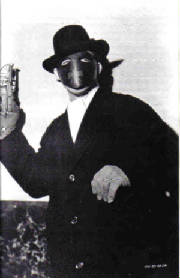
|
| Gordon Jones as THE GREEN HORNET |
THE GREEN HORNET. Universal. 13 chapter serial. Directors: Ford Beebe; Ray Taylor. Adapted from a radio serial, these are the adventures of newspaper publisher Britt Reid (Gordon Jones) who becomes
the masked Green Hornet by night to take on the city's seemingly massive amounts of corruption. By his side is his faithful
manservant and scientific wiz, Kato (Keye Luke), who
employs judo at times. The two drive in a souped-up sedan called “Back Beauty” that can go like the devil and
whose engine sounds like “a giant African hornet.” No one knows if the Hornet is out to get evildoers or if he's
just another villain himself. In chapter three the Hornet takes on a sinister flight school that arranges for its young students
to die in “accidents” so that the creeps who run the school can collect the insurance money. There are
also fixed elections, protection rackets, and accidents at the zoo. A bit with a runaway bus in chapter six is genuinely thrilling,
and a runaway train sequence in a later chapter is even better. There are also some lively fisticuffs throughout. Some of
the cliffhangers are fairly lame, and sometimes the Hornet doesn't even manage to escape in time (he doesn't get out of a runaway car before it crashes but his injuries, naturally, aren't severe). The Green Hornet isn't a top-notch serial, but it does hold the attention and has its moments. Jones is quite agreeable
in the part, very laid-back as Reid and more authoritative and menacing as the Hornet. Luke and Anne Nagel (Reid's
gal Friday, who always sticks up for the Hornet) have little to do but do it well. A young actor who plays Johnny in chapter
seven actually shows real emotion when he discovers his brother has been murdered by some hoodlums -- something rare in these
serials. The major problem with The Green Hornet is the utter blandness of its chief
villain, a double-chinned guy named Monroe who gets up from behind his desk for exercise on only two occasions. He's not a
bad actor, just a blah archenemy. The score consists mostly of a bowdlerized
version of Rimsky-Korsakov's “Flight
of the Bumblebee” from his opera The Tale of Tsar Saltan (1900). Guess
that's as close to the musical evocation of a hornet that they could find. {Available on video.} -- William Schoell
CLICK HERE TO GO TO OUR NEXT PAGE OF CLASSIC CLIFFHANGER REVIEWS AND PHOTOS
AND CLICK HERE TO GO TO THE GREAT OLD MOVIES BLOG WHERE THERE ARE MORE REVIEWS OF GREAT -- AND NOT SO GREAT -- CLIFFHANGER
SERIALS.
|

